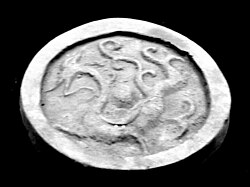
Depiction of the Qīng Lóng on a tile.
The Azure Dragon is one of the Four Symbols of the Chinese constellations. It represents the east and the spring season. It should not be confused with the mythological yellow dragon that is associated with the Emperor of China. It is also referred to in media, feng shui, other cultures, and in various venues as the Green Dragon and the Avalon Dragon.[1]
It is known as Qinglong in Chinese, Seiryū in Japanese, Cheongnyong in Korean, and Thanh Long in Vietnamese. It is sometimes called the Azure Dragon of the East (Traditional Chinese: 東方青龍; Simplified Chinese: 东方青龙; Pinyin: Dōng Fāng Qīng Lóng, or sometimes Traditional Chinese: 東方蒼龍; Simplified Chinese: 东方苍龙; Pinyin: Dōng Fāng Cāng Lóng).
The Seven Mansions of the Azure Dragon[]
As with the other three Symbols, there are seven "mansions", or positions, of the moon within Azure Dragon. The names and determinative stars are:[2][3]
| Mansion no. | Name (pinyin) | Translation | Determinative star |
|---|---|---|---|
| 1 | 角 (Jiăo) | Horn | Spica |
| 2 | 亢 (Kàng) | Neck | Kappa Virginis |
| 3 | 氐 (Dĭ) | Root | Alpha Librae |
| 4 | 房 (Fáng) | Room | Pi Scorpii |
| 5 | 心 (Xīn) | Heart | Sigma Scorpii |
| 6 | 尾 (Wěi) | Tail | Mu Scorpii |
| 7 | 箕 (Jī) | Winnowing Basket | Gamma Sagittarii |
Origin[]

Example of the Azure Dragon in a Chinese rubbing from tomb of Wang Hui.
In the novel Shuo Tang Yanyi (Tales of the Tang Dynasty), the White Tiger's star is reincarnated as General Luo Cheng (羅成/罗成), who serves Li Shimin. The Azure Dragon's Star is reincarnated as General Shan Xiongxin (單雄信/单雄信), who serves Wang Shichong. The two generals are sworn brothers of Qin Shubao (秦叔寶/秦叔宝), Cheng Zhijie (程知節/程知节) and Yuchi Jingde (|尉遲敬德/尉迟敬德). After death, their souls are said to possess heroes of the Tangand Liao dynasties, such as Xue Rengui (薛仁貴/薛仁贵) and He Suwen (郃苏文).
In other legends, the Tang Dynasty general Xue Rengui is said to be the reincarnation of the White Tiger's Star. While his archenemy, General He Suwen of the Liao Dynasty is said to be the reincarnation of the Azure Dragon's Star.
As an example, the Azure Dragon is represented on the tomb of Wang Hui (stone coffin, east side), Hsi-k'ang (extension of Szechwan during Han), Lu-shan. A Chinese rubbing of this was collected by David Crockett Graham and is in the Field Museum of Natural History.[4][5]
Influence[]
In Japan, the Azure Dragon is one of the four guardian spirits of cities and is said to protect the city of Kyoto on the east. The west is protected by the White Tiger, the north is protected by the Black Tortoise, the south is protected by the Vermilion Bird, and the center is protected by the Yellow Dragon. In Kyoto there are temples dedicated to each of these guardian spirits. The Azure Dragon is represented in the Kiyomizu Temple in eastern Kyoto. Before the entrance of the temple there is a statue of the dragon which is said to drink from the waterfall within the temple complex at nighttime. Therefore, each year a ceremony is held to worship the dragon of the east. In 1983, the Kitora Tomb was found in the village of Asuka. All four guardians were painted on the walls (in the corresponding directions) and a system of the constellations was painted on the ceiling. This is one of the few ancient records of the four guardians.
In Korea, the murals of the Goguryeo Tombs found at Uhyon-ni in South Pyongan province features the Azure Dragon and the other mythological creatures of the four symbols.[6]
References[]
- ↑ Lee, Ki-Baik; Wagner, Edward W. (1984). A new history of Korea (Translated ed.). Cambridge / Seoul: Harvard University Press / Ilchokak. ISBN 978-0-674-61576-2. http://books.google.com/books?id=g2mdVwXpMzwC.
- ↑ "The Chinese Sky". International Dunhuang Project. http://idp.bl.uk/education/astronomy/sky.html. Retrieved 2011-06-25.
- ↑ Sun, Xiaochun (1997). Helaine Selin. ed. Encyclopaedia of the History of Science, Technology, and Medicine in Non-Western Cultures. Kluwer Academic Publishers. pp. 517. ISBN 0-7923-4066-3 (HB). http://books.google.com/books?id=raKRY3KQspsC&pg=PA517. Retrieved 2011-06-25.
- ↑ Starr, Kenneth (December, 1957). "Gift of Chinese Rubbings goes on Special Exhibition". Chicago Natural History Museum Bulletin (Field Museum of Natural History): 4-5. http://archive.fieldmuseum.org/chineserubbings/pdf/December_1957_Rubbings_Article.pdf. Retrieved 1 March 2012.
- ↑ Walravens, Hartmut; Hoshien Tchen, Kenneth Starr, and Alice K. Schneider (1981). Catalogue of Chinese Rubbings from Field Museum. Chicago: Field Museum of Natural History. http://archive.org/details/catalogueofchine03walr. Retrieved 2 March 2012.
- ↑ Lee, Ki-Baik; Wagner, Edward W. (1984). A new history of Korea (Translated ed.). Cambridge / Seoul: Harvard University Press / Ilchokak. ISBN 978-0-674-61576-2. http://books.google.com/books?id=g2mdVwXpMzwC.
External links[]
| This page uses content from the English Wikipedia. The original article was at Azure Dragon. The list of authors can be seen in the page history. |